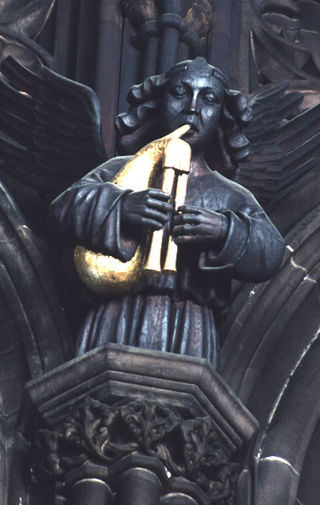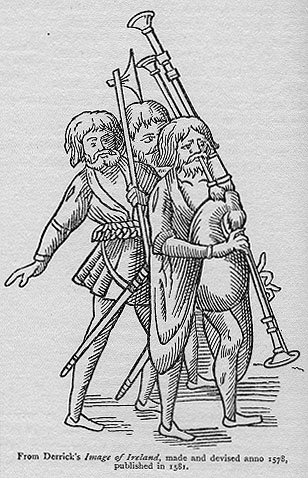Related Research Articles

Bagpipes are a woodwind instrument using enclosed reeds fed from a constant reservoir of air in the form of a bag. The Great Highland bagpipes are well known, but people have played bagpipes for centuries throughout large parts of Europe, Northern Africa, Western Asia, around the Persian Gulf and northern parts of South Asia.

The chanter is the part of the bagpipe upon which the player creates the melody. It consists of a number of finger-holes, and in its simpler forms looks similar to a recorder. On more elaborate bagpipes, such as the Northumbrian bagpipes or the Uilleann pipes, it also may have a number of keys, to increase the instrument's range and/or the number of keys it can play in. Like the rest of the bagpipe, they are often decorated with a variety of substances, including metal (silver/nickel/gold/brass), bone, ivory, or plastic mountings.

The great Highland bagpipe is a type of bagpipe native to Scotland, and the Scottish analogue to the great Irish warpipes. It has acquired widespread recognition through its usage in the British military and in pipe bands throughout the world.

Dame Evelyn Elizabeth Annie Glennie, is a Scottish percussionist. She was selected as one of the two laureates for the Polar Music Prize of 2015.

Scotland is internationally known for its traditional music, which remained vibrant throughout the 20th century and into the 21st when many traditional forms worldwide lost popularity to pop music. Despite emigration and a well-developed connection to music imported from the rest of Europe and the United States, the music of Scotland has kept many of its traditional aspects and influenced many other forms of music.
The Northumbrian Pipers' Society was founded to promote both types of Northumbrian bagpipes – the Northumbrian smallpipes and the half-long pipes, now generally known as the Border pipes. There had been several attempts to encourage the pipes and their music during the 19th century, but no society was formed with this specific aim until the Northumbrian Small Pipes Society in 1893. That society organised a series of competitions, in which Richard Mowat and Henry Clough were both prizewinners. However it was short-lived, dissolving around 1899. Today the society is divided into two branches, the main branch based in Morpeth, and the Cleveland branch based in Sedgefield.

Welsh bagpipes The names in Welsh refer specifically to a bagpipe. A related instrument is one type of bagpipe chanter, which when played without the bag and drone is called a pibgorn (English:hornpipe). The generic term pibau (pipes) which covers all woodwind instruments is also used. They have been played, documented, represented and described in Wales since the fourteenth century. A piper in Welsh is called a pibydd or a pibgodwr.
Chì mi na mòrbheanna is a Scottish Gaelic song that was written in 1856 by Highlander John Cameron. The song's tune was performed on the bagpipes during the state funerals of John F. Kennedy in 1963, Queen Elizabeth The Queen Mother in 2002, Queen Elizabeth II in 2022, Former Ontario Lieutenant Governor David Onley in 2023 and Former Canadian Prime Minister Brian Mulroney in 2024.

The Associação Gaita-de-fole is a non-profit organization, founded officially in 1994 by enthusiasts of the Portuguese folk traditions — specially the related with the Transmontan and Galician bagpipes. The volunteers contribute in a variety of ways, as artisans, musicians, anthropologists and teachers, both professional and amateurs.

Blowzabella is an English folk band formed in London in 1978. The band currently consists of Andy Cutting, Jo Freya, Paul James, David Shepherd, Barn Stradling, and Jon Swayne; members of the band have changed multiple times since late 1982, with Jon Swayne being the only remaining original band member. It is estimated that Blowzabella musicians played between 26 and 32 instruments in total, which include bagpipes, hurdy-gurdy, diatonic button accordion, alto sax, and triangle. Their music is heavily influenced by English and European traditional folk music, and has inspired a variety of European folk bands with their unique style and sound. Many European folk artists attribute Blowzabella as a major influence in their music.

When bagpipes arrived in England is unknown, there is some evidence to suggest Anglo-Saxon times, however the oldest confirmed proof of the existence of bagpipes anywhere in the world comes from three separate sources in the 13th century. Two of them English; the Tenison Marginalie Psalter from Westminster and an entry into the accounts books of Edward the I of England recording the purchase of a set of bagpipes. The third from the Cantigas Del Santa Maria published in Spain. From the 14th century onwards, bagpipes start to appear in the historical records of European countries, however half the mentions come from England suggesting Bagpipes were more common in England.
The surdelina, sourdeline or sampogna was a kind of bag pipe which was described and illustrated by Mersenne as the musette de Naples or musette de Italie its construction was very complicated. Mersenne states that the instrument was invented by Jean Baptiste Riva, Dom Julio and Vincenze; but Mersenne seems to have made alterations himself in the original instrument, which are not very clearly explained. There were two chanters with narrow cylindrical bore and having both finger-holes and keys; and two drones each having ten keys. The four pipes were fixed in the same stock, and double reeds were used throughout; the bag was inflated by means of bellows.
It is unclear whether Lincolnshire bagpipes refer to a specific type of pipes native to Lincolnshire, England, or to the popularity of a more general form of pipes in the region. Written records of bagpipes being associated with Lincolnshire date back to 1407, but it is difficult to find certain proof that any regional variation of the bagpipe existed which was peculiar to Lincolnshire. Despite the lack of evidence for a uniquely local instrument, it is clear that the bagpipe was enjoyed by the people of Lincolnshire.

Irish warpipes are an Irish analogue of the Scottish great Highland bagpipe. "Warpipes" is originally an English term. The first use of the Gaelic term in Ireland was recorded in a poem by Seán Ó Neachtain, in which the bagpipes are referred to as píb mhór.
The mashak is a type of bagpipe found in Northern India, Uttarakhand, Sudurpaschim Province of Nepal and parts of Pakistan and Afghanistan. The pipe was associated with weddings and festive occasions. In India it is historically found in Kumaon and Garhwal in Uttarakhand, Rajasthan and Uttar Pradesh. This bagpipe uses single reeds, and can be played either as a drone or as a melody instrument.
William Alfred Cocks (1892-1971) was a master clock maker from Ryton, County Durham. He had a lifelong interest in the history and culture of the North-east of England, and particularly in the Northumbrian smallpipes and half-long pipes. He assembled a large collection of historic bagpipes, their music, and related materials, which forms the core of the collection now housed at the Morpeth Chantry Bagpipe Museum. He was elected to the Society of Antiquaries of Newcastle upon Tyne in 1920, remaining a member until his death. In 1928, he was one of the earliest members of the Northumbrian Pipers' Society, being elected one of the technical advisers, with responsibility for smallpipes. He became a Vice-President of the Society in 1938. When an exhibition of historic pipes was held in the Black Gate Museum in 1961, most of the exhibits were from Cocks's collection.

McCallum Bagpipes Limited is a company that manufactures Great Highland bagpipes. Founded in 1998, it is based in Kilmarnock, Scotland. The company has worked with bagpiper Willie McCallum to design several products.
Börs Anders Öhman is a Swedish folk musician born in 1949 in Valparaiso, Chile. He is a Swedish bagpipe maker and innovator.
References
- ↑ "Guide". www.bagpipesociety.org.uk. Retrieved 2018-06-19.
- ↑ "Pitt Rivers Museum". Prm.ox.ac.uk. Retrieved 8 April 2013.
- ↑ "Oxford Mail". Oxfordmail.co.uk. Retrieved 10 April 2013.
- ↑ "The Scotsman". Scotsman.com. Retrieved 10 April 2013.
- ↑ "International Bagpipe Day and Conference". www.bagpipesociety.org.uk. Retrieved 2018-06-19.